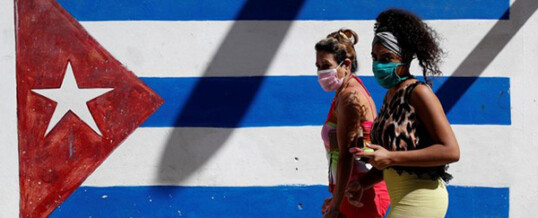
McLeod Group guest blog by John M. Kirk, October 29, 2020
As the cold winter looms, along with the dreaded “second wave” of COVID-19, Canadians are faced with some alarming facts. While pleased that our infection and death rates are only half those found in the United States, we are doing poorly compared with one country barely mentioned in our media: Cuba. Their death rate (adjusted to population differences) is roughly 1/25 what ours is, while Canadians are ten times more likely to become infected by the virus than Cubans.
How did they manage to do this? Is there anything that we can learn from them?
The world is in a parlous state. There is the possibility that 500,000 Americans might die by February. The intensive care wards are rapidly filling up in Europe. In Canada, we are now hitting almost 1,000 new cases daily in the two most populous provinces of the country, Ontario and Quebec.
Yet, Cuba has managed to control the situation there, with fewer than 7,000 people infected and 128 dead. It has also faced, and curbed, a second wave of infections. Cubans are also over 40 times less likely to contract the virus than people in the United States. Countries of a similar size to Cuba offer interesting data in terms of fatalities. As of October 25, Cuba has experienced 128 deaths, compared with 10,737 in Belgium, 2,081 in Switzerland, 2,297 in Portugal, 5,933 in Sweden, and 1,390 in Hungary.
While there are some aspects of the Cuban model that are not transferable to Canada – largely because of radically different political systems – there are things that we can learn from them.
Cuba is fortunate that it is a small country, with 11.2 million people in an island about twice the surface area of Nova Scotia. It also has an excellent healthcare system, with three times the number of physicians per capita as Canada – the highest rate in the world. Its system emphasizes preventive medicine, as opposed to the curative approach used here. The Cubans moved with enormous speed to limit COVID-19, in part because of a finely tuned system to respond to natural disasters.
When COVID arrived in the island in March, brought by Italian tourists, the government decided to forego the funds derived from the tourism industry, and closed the island to tourists. Healthcare for all was deemed far more important than economic growth.
One of the first steps when the virus was detected was to mobilize medical and nursing students, who were tasked with going door to door throughout the island, asking people if they presented any of the symptoms of the virus. In all, some 28,000 students participated, presenting their findings to the local family doctors, who then followed up by visiting their patients.
Cubans who presented symptoms were transferred to designated isolation facilities where they stayed for 14 days, until they tested negative. In all, more than 115,000 Cubans – both those who had tested positive for the virus and their contacts – were isolated in such facilities, and tested daily. Less than 5% in these isolation facilities tested positive for the virus, but the Cuban approach was to protect the population at large, regardless of the costs incurred.
In mid-October, as the numbers of infected Cubans decreased, the government decided that patients could now stay in their own homes. Strict guidelines were issued and family doctors – most of whom live within the community they serve – were instructed to maintain daily contact with patients until they tested negative.
The government employed other strategies as well. It issued fines to all who refused to obey health instructions concerning the size of gatherings or the need to wear masks in public and maintain distance in communal spaces. Leading Cuban epidemiologists and health representatives presented daily reports in all national media. Schools were closed until the conditions had improved, and all public sports and cultural events were suspended. Businesses were closed, and non-essential travel banned. Cuba has also developed its own vaccine, Soberana 01, currently in clinical trials.
In sum, Cuba has made the health of society at large its priority. It has employed strict control measures to test and trace people suspected of having the virus or being in contact with infected subjects. It emphasizes preventive healthcare and isolation of patients. And, when the virus resurfaced it used strict lockdown measures – ensuring that people stayed at home, while providing food, social and medical services to the population.
Political will, a centralized, national approach to dealing with COVID and close collaboration with grassroots communities, have shown that the virus can be controlled.
John M. Kirk is Professor of Latin American Studies at Dalhousie University, and the author/co-editor of 17 books on Cuba, including two on its healthcare system. Photo: CLACSO.
